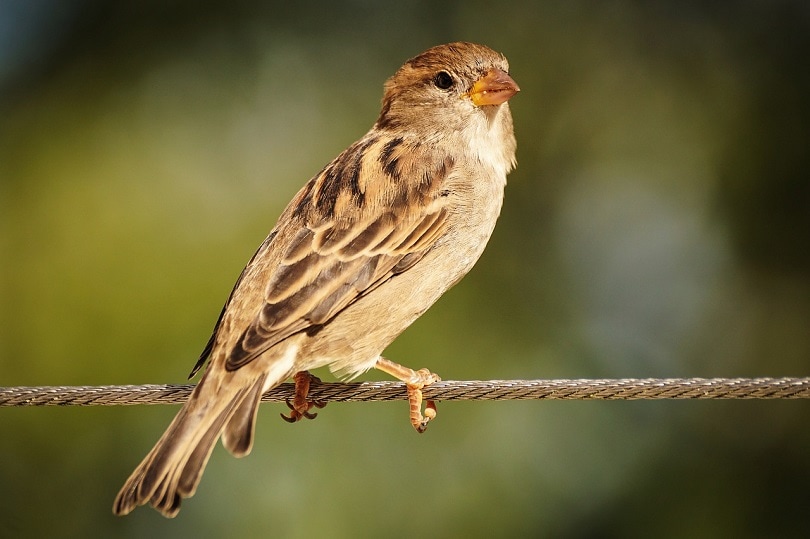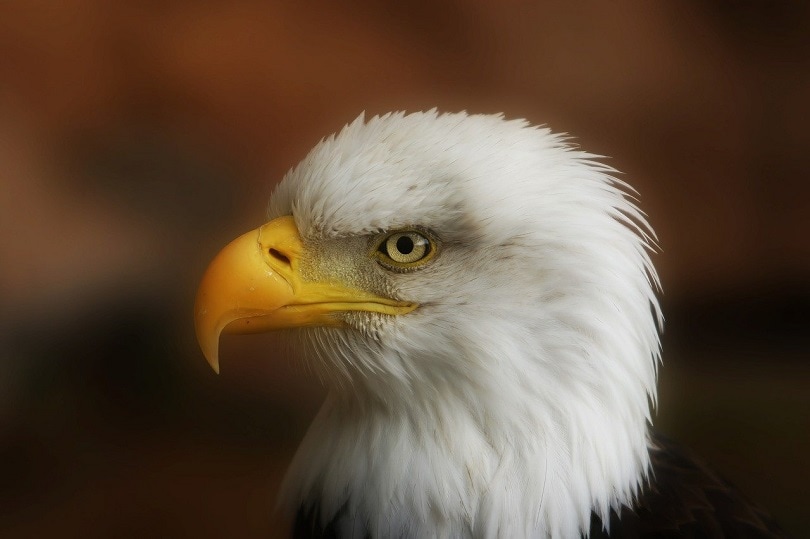6 Types of Bird Feathers – A Complete Guide (with Pictures)
Last Updated on

Feathers are unique to birds: No other type of animal has them. Used for flight, feathers also serve to protect birds from rain, camouflage against predators, and help attract a mate with impressive displays. They consist primarily of keratin, which is the same substance that makes up nails, skin, and human hair. Depending on the species, a bird can have anywhere from 1,500 to 25,000 feathers. In fact, in some cases, a bird’s feathers can be substantially heavier than its entire skeleton.
Below are the six main categories or types of bird feathers as well as their properties and their uses.
The corresponding feathers in the image above in relation to what we describe below are as follows: 1. contour feather (D), 2. semiplumes (F), 3. down feathers (E), 4. filoplumes (A), 5. bristles (B), 6. powder down feathers (C).
The 6 Types of Bird Feathers Are:
1. Contour Feather
The contour feather is flexible but rigid, a feat that has been achieved by having barbs on the central shaft. These barbs have their own barbs, giving what is essentially an articulated finish. The contour feathers on the inner wing are important for lift during flight, while the outer wing feathers provide thrust to propel the bird through the air.
If the barbs separate from the vane, which does happen, the bird can repair it by preening. They fluff up and then shake their feathers, which helps the barbs hook back on the vane. The bird will then coat the vane in a natural oil that is secreted at the base of the feather and pushed along by the beak.
2. Semiplumes

Semiplumes have several similar features. They are barbed, like contour feathers, but they are commonly found under the contours. The vanes tend to fluffy.
Semiplumes provide insulation, but in some species of birds, they are also used during courtship displays.
3. Down Feathers

If you have a luxury duvet, you may have heard of down feathers. Like semiplumes, they sit under the contour feathers and are used for insulation. Specifically, they trap air that gets under the outer feathers, and this air acts as a layer of insulation to protect the bird from cold and even provide a barrier against the wind.
Down feathers have a smooth appearance, which is formed because the barbs do not join together, so there is no vane down the center.
4. Filoplumes
Filoplumes are specialist feathers, which means that they serve a specific purpose. The feathers have few barbs, and these are only found at the ends of the feathers, near the tips.
The filoplumes are located around the contour feathers and provide sensory information on wind speed and power, air pressure, and other environmental factors and feather movements to assist in efficient flight.
5. Bristles
Bristles are stiff because they do not have any barbs, except at the very base. These short feathers are believed to be sensory, and they are commonly found on birds that feed on the wing, around their mouth and eyes. In some cases, the bristles are used to herd small insects into the mouth of flying birds as a means of feeding and for sustenance. They are most commonly found on these insectivorous birds but can also be found on other species.
6. Powder Down
The powder down is similar to the semiplume. It is a soft feather that is found around the chest and pelvic regions of birds like herons and bitterns. They do have barbs, and these grow continuously, but they break down when bitten. The powder down feathers are most commonly used during preening and as a method of waterproofing other feathers.
Related Read: Do All Birds Have Feathers? Why Do They Have Them?

Conclusion
Birds are incredible animals, and their feathers are part of the reason that they can fly, swoop, glide, and perform incredible aerial acrobatics. They are also used to protect against rain and as a form of insulation to keep the bird warm.
Although there are hundreds of different feather colors, markings, sizes, and patterns, all feathers can be considered to belong to one of these six groups.
Before you go… check out some of our other top-trending posts:
- Who Invented the Telescope and When? A Complete History
- 4 Types Of Blue Bird Species In The US (with Pictures)
- 15 Bird Documentaries and Movies Worth Watching
Featured Image Credit: suju-foto, Pixabay
About the Author Robert Sparks
Robert’s obsession with all things optical started early in life, when his optician father would bring home prototypes for Robert to play with. Nowadays, Robert is dedicated to helping others find the right optics for their needs. His hobbies include astronomy, astrophysics, and model building. Originally from Newark, NJ, he resides in Santa Fe, New Mexico, where the nighttime skies are filled with glittering stars.
Related Articles:
How to Clean a Refractor Telescope: Step-by-Step Guide
How to Clean a Telescope Eyepiece: Step-by-Step Guide
Monocular vs Telescope: Differences Explained (With Pictures)
How to Choose Binoculars for Bird Watching: 10 Expert Tips
How to Clean a Rifle Scope: 8 Expert Tips
What Is a Monocular Used For? 8 Common Functions
How to Clean a Telescope Mirror: 8 Expert Tips
Brightfield vs Phase Contrast Microscopy: The Differences Explained
